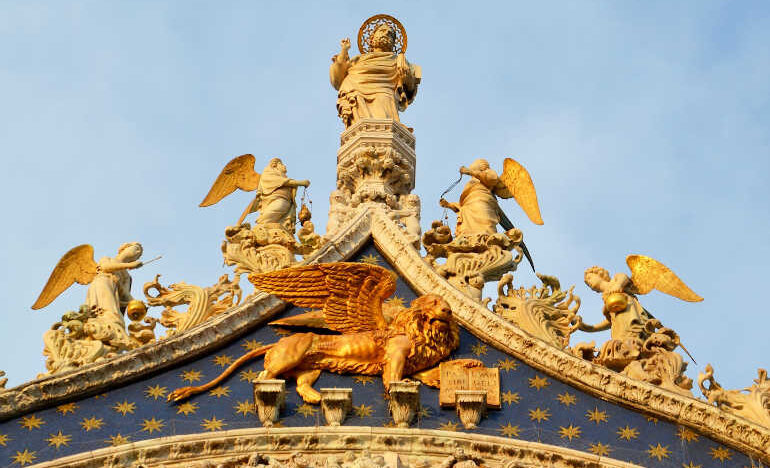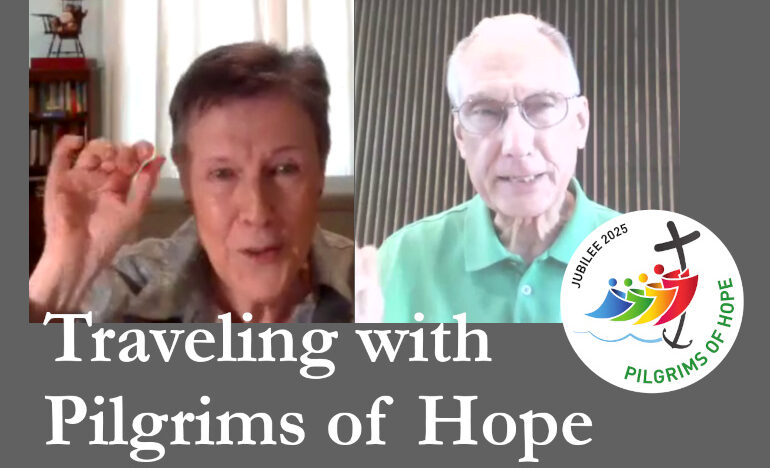The Gospel of Mark: Out of the Desert

Part 4 of 4. All the articles are here.
Author’s Note: During the 2021 liturgical year, we are reading from the Gospel according to Mark at Sunday services. Let’s take time to study together the Jesus whom Mark reveals. Read these articles and join our mini-retreat.
In Christian art, each of the four evangelists has a symbol. Mark’s symbol is a winged lion, which references the Prophet Isaiah when he begins his Gospel:
Here begins the Gospel of Jesus Christ, the Son of God. In Isaiah the prophet it is written: “I send my messenger before you to prepare your way: a herald’s voice in the desert, crying, ‘Make ready the way of the Lord, clear Him a straight path.’”
“The voice in the desert crying” reminds one of a lion’s roar, and the prophetical spirit descending to earth reminds one of a “winged message.” The lion also signified royalty, an appropriate symbol for the Son of God.
Note: Never miss an article published on the Renewal Center website: Sign up to receive our newsletters
Mark begins his Gospel in the desert. A good rain can produce a miracle in just about any desert. Seeds buried in dry earth are able to lie waiting for months, even years. Suddenly, in the right conditions, they sprout, and the desert floor bursts with color and life.
In a way, Israel waiting for the Messiah was like a desert waiting to burst into bloom. For many years, the nation had endured exile and oppression, with only occasional flashes of hope. King David’s once vibrant dynasty lay dormant, and the people were constantly tempted to follow the ways of the pagans around them. But God had spoken to this desert and promised a “shoot … from the stump of Jesse,” who would establish a kingdom of righteousness (Is 11:1).
Then, centuries later, it happened! Jesus was born into David’s lineage, and he ushered in the kingdom with a breathtaking display of power and grace.
But there’s a twist.
Jesus’ ministry produced a different sort of “bloom” than what many were expecting. He had come to rescue people from sin, not Roman imperialism. And his great victory was won on the cross, not at the head of a liberating army. Still, for those who believed in him, the desert came alive with all the vibrant colors of grace, mercy, and joy.
Have you been through a desert this past year?
Our physical environment outside right now creates a feeling of oppression — trees are bare, grass is brown, nights and days are cold. That environment actually helps us understand the Gospel according to Mark and the audience Mark was trying to reach.
As mentioned earlier, Mark was writing for a community filled with anxiety. Nearly 40 years had passed since the resurrection and ascension of Jesus, but he had not yet returned as the Christian community had expected. Jerusalem was under siege by the Romans, and the persecution of Christians in Rome was intensifying. Peter and Paul had died, and only a few eyewitnesses to Jesus’ ministry were left.
It is likely that Mark wrote for his suffering community in the neighborhoods of Rome. Mark himself had not heard Jesus preach, but he listened intently to his mentor, St. Peter.
Fr. Ron’s mini-retreat with Mark’s Gospel will be on Tuesday evening Feb. 9 or Saturday morning of Feb. 13.
Mark is a Gospel, not a history or biography; it is “a work of faith addressed to faith.” Apologetic, doctrinal, and catechetical themes are visible in Mark. These dictate the arrangement of his material; he is therefore not a historical source for the chronological order of the events. Nor is he interested merely in reporting what was observed and transmitted. He presents the events as moments in the process of salvation, as transformed by faith and understanding which comes from the passion and resurrection.
Why did Mark choose to write these particular words for his Gospel? How did Mark decide what was important enough to record for us?
I encourage you to read the entire Gospel according to Mark in one sitting. The following outline of his Gospel will help you follow his storyline. Have the outline in hand as you read the Gospel.
Prologue: Teaching of John, baptism and temptation of Jesus (1:1-13)
The Galilean Ministry (1:14-6:6a)
- Capernaum and the surrounding district (1:14-45)
- Conflict of Jesus and the Jews (2:1-3.6)
- Success of Jesus and further conflicts (3:7-35)
- The parables (4:1-34)
- Four miracles at the Sea of Galilee (4:35-5:43)
- Conclusion of Galilean ministry; rejection at Nazareth (6:1-6a)
The Journeys of Jesus (6:6b-10-52)
- Mission of the apostles (6:6b-29)
- Journey and return, feeding of 5000, controversy (7:1-23)
- Journey and return, miracles, controversy ((7:24-8:12)
- Journey and return, cures, confession of Peter, prediction of Passion, transfiguration (8:13-9:50)
- Journey to Jerusalem, controversy, instructions, cure of blind man (10:1-52)
Ministry in Jerusalem, Passion and Death, Resurrection (11:1-16:8)
- Messianic activity (11:1-26)
- Messianic teaching (11:27-12:44)
- Apocalypse (13:1-37)
- Jesus and his disciples (14:1-42)
- Jesus tried by the Jews (14:43-72)
- Jesus tried by Pilate and crucified (15:1-47)
- The Risen Jesus (16:1-8)
Appendix (16:9-20)
Some scripture scholars say that Mark is a Passion Narrative with an extended introduction. If we read the Gospel through that lens, we can see how all of Jesus’ teaching and healing along the way as he travels to Jerusalem is actually his journey to the Cross. Chapter 3:6 describes the first organized plot against Jesus. The Cross shines early over Jesus.
The true character of Jesus is progressively manifested throughout Galilee, the journeys, and the ministry in Jerusalem; but for Mark the whole revelation of the true Jesus comes with his death and resurrection. Without this he cannot be understood nor accepted. The plan of the Gospel itself is therefore an element in the theology of the Gospel.
During our present liturgical year we are reading from the Gospel according to Mark at Sunday Mass. Let’s take time to study together this “Jesus” whom Mark reveals.
I invite you to a Mini-Retreat with Mark.
Information about how to register for the Mini-Retreat is on the Renewal Center website now. Click on the following links to learn more. It will be offered on Tuesday, February 9, 6:30 to 8:30 p.m. central time and offered again on Saturday, February 13, 10 a.m. to noon central time.
Note: Never miss an article published on the Renewal Center website: Sign up to receive our newsletters
[Fr. Ron Will, a Precious Blood priest and spiritual director, is a graduate of Catholic Theological Union and Creighton University’s School of Christian Spirituality. He has a special interest in helping form intentional disciples of Jesus, encouraging others to go spiritually deep-sea diving to explore a deeper relationship with God, and walking with people as they dive into the ocean of God’s mystery actually experiencing God rather than simply dipping one’s toe into the water.]
The image above is St. Mark’s Basilica in Venice, Italy, topped by a statue of the saint and his symbol, a winged lion. Image by Sarah Lötscher from Pixabay
We’d Like to Hear From You!
We’d like to know what you think about this article. Send us a comment using the form below. Do you have a suggestion? Is there something you want to learn more about? Send us a note.
Related

Take Nothing for the Journey
An Assembling God’s Puzzle video
By Fr. Garry Richmeier, C.PP.S.
Jesus’ teaching about what to take on a journey — nothing — is actually good advice for building trusting relationships. Don’t bring your “stuff” into the relationship; listen deeply and respec their views and situation, understand their struggles.

Pilgrims of Hope, Episode 6: Walking with Cancer Survivors
Hosted by Fr. Ron Will, C.PP.S.
We are talking with people who find hope amid difficult circumstances or bring hope to others. In this episode, Kathy Keary talks about how centering prayer, journaling and other spiritual practices helped her cope with two life threatening health issues.
Categories
Assembling God's Puzzle Coffee with Padre Cooking & Spirituality Encounters of the 4th Kind Family Matters Reflections on the Eucharsitic Prayers Spiritual Resources Taize Prayers The Contemplative Life Traveling with Pilgrims of Hope Uncategorized Videos Week of Prayer for Uhristian Unity When you need a little help
